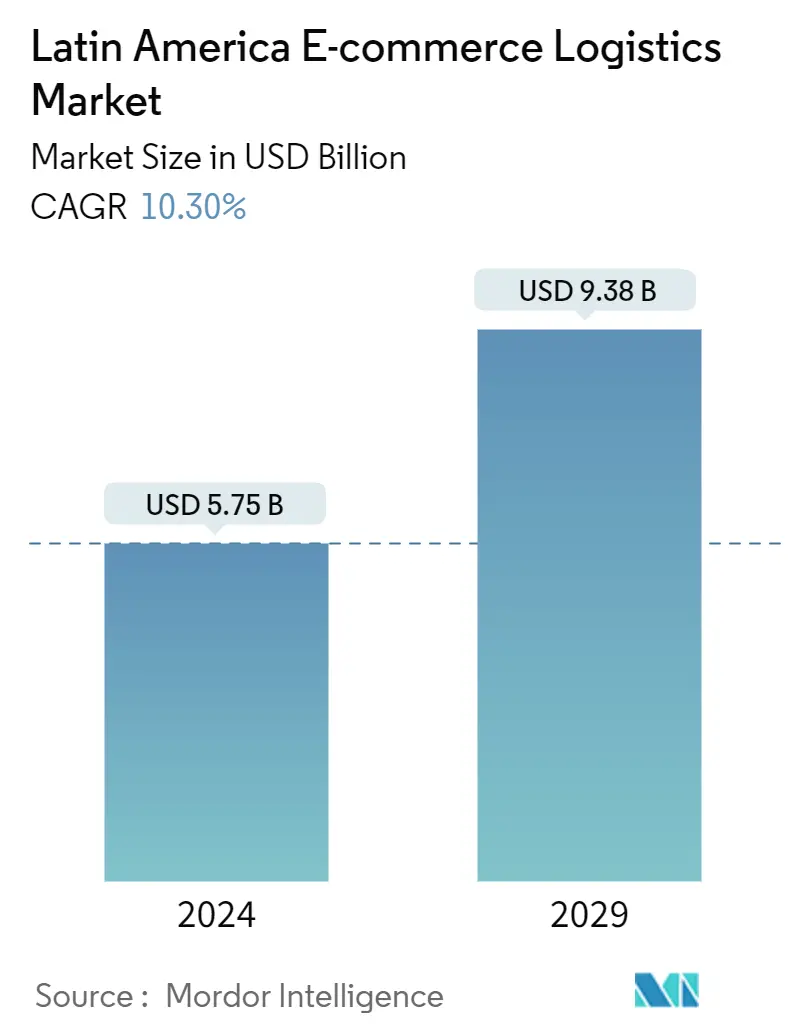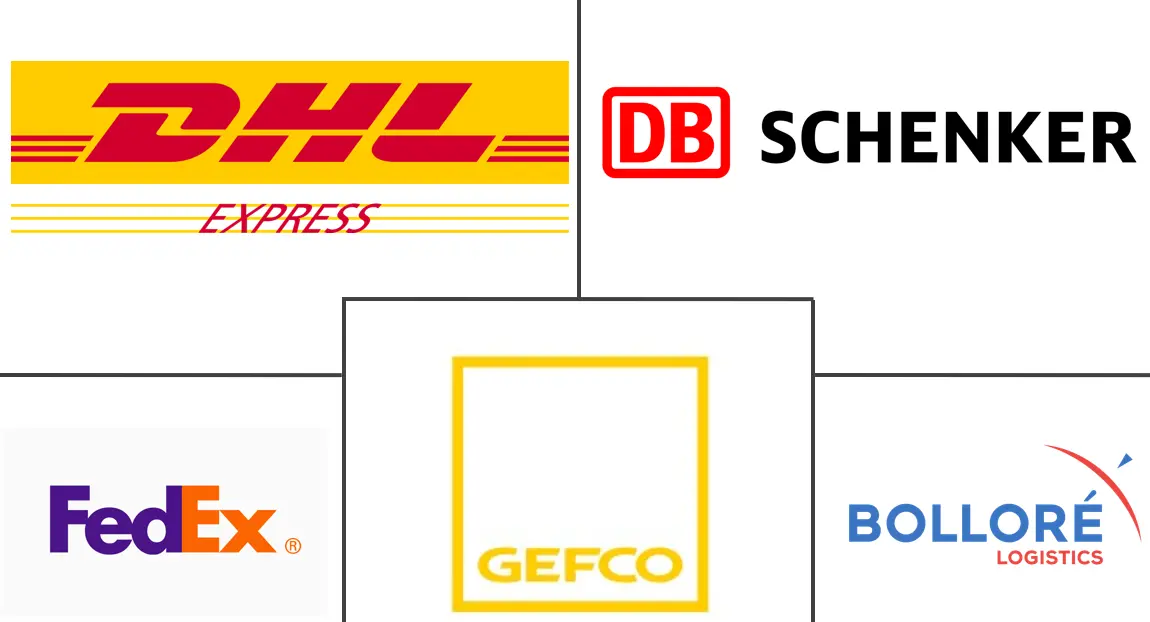Market Size of Latin America E-commerce Logistics Industry

| Study Period | 2020-2029 |
| Base Year For Estimation | 2023 |
| Market Size (2024) | USD 5.75 Billion |
| Market Size (2029) | USD 9.38 Billion |
| CAGR (2024 - 2029) | 10.30 % |
| Market Concentration | High |
Major Players
*Disclaimer: Major Players sorted in no particular order |
Latin America E-commerce Logistics Market Analysis
The Latin America E-commerce Logistics Market size is estimated at USD 5.75 billion in 2024, and is expected to reach USD 9.38 billion by 2029, growing at a CAGR of 10.30% during the forecast period (2024-2029).
- The COVID-19 pandemic spurred significant growth in the digital realm in 2020, notably benefiting e-commerce. Latin America experienced exponential growth in online shopping, with several countries reporting substantial increases in online purchases, serving as a primary driver for the market.
- The Latin American e-commerce market stands as a global leader in growth, expected to surpass the global average of 14% (as reported in 2021), with an anticipated growth rate of 19% over the forecast period. This robust expansion offers immense opportunities for the e-commerce logistics market.
- The surge in demand for home delivery catalyzed the growth of specific e-commerce segments like food and beverage, which had been gaining popularity in recent years. The digitalization of shopping habits has transcended the initial impact of the coronavirus, becoming an increasingly entrenched aspect of people's daily lives.
- Several significant factors contribute to this market growth, including the rise of e-commerce businesses, the surge in sales, and technological advancements across Latin America. The proliferation of mobile internet usage has also played a pivotal role, enabling people to search for products more conveniently.
- Countries like Brazil, Argentina, and Chile heavily rely on road transportation for moving agricultural products and fertilizers across long distances. Thus, the dependence on efficient logistics and transportation networks ensures competitiveness, indicating a continual growth trajectory for the e-commerce logistics market in Latin America.
Latin America E-commerce Logistics Industry Segmentation
E-commerce logistics refers to transportation services provided to the online retail market. For an e-commerce company, logistics in the forward direction involve receiving an online order, arranging for the item, packaging, preparing its invoice, setting the payment, dispatching, and delivering the thing to the customer's doorstep.
The market is segmented by service (transportation, warehousing, inventory management, and value-added services (labeling, packaging, etc.)), business (B2B and B2C), destination (domestic and international/cross-border), product (fashion and apparel, consumer electronics and home appliances, beauty and personal care products, and other products (toys, food products, furniture, etc.)), and country (Brazil, Mexico, Colombia and Rest of Latin America).
The report offers market size and forecasts for the Latin America E-commerce logistics market in value (USD) for all the above segments.
| By Service | |
| Transportation | |
| Warehousing and Inventory Management | |
| Value-Added Services (Labeling, Packaging, etc.) |
| By Business | |
| B2B (Business-to-Business) | |
| B2C (Business-to-Customrs) |
| By Destination | |
| Domestic | |
| International/Cross-border |
| By Product | |
| Fashion and Apparel | |
| Consumer Electronics and Home Appliances | |
| Beauty and Personal Care Products | |
| Other Products (Toys, Food Products, Furniture, etc.) |
| By Country | |
| Brazil | |
| Mexico | |
| Colombia | |
| Rest of Latin America |
Latin America E-commerce Logistics Market Size Summary
The Latin America e-commerce logistics market is poised for significant expansion, driven by the region's rapid adoption of online shopping and digital payment systems. The COVID-19 pandemic acted as a catalyst, accelerating the shift towards e-commerce as consumers increasingly turned to online platforms for their shopping needs. This shift has been supported by the proliferation of mobile internet usage and technological advancements, which have made it easier for consumers to access a wider range of products. Countries like Brazil, Argentina, and Chile are central to this growth, with their reliance on efficient logistics networks to support the movement of goods across vast distances. The market's growth trajectory is further bolstered by the increasing demand for home delivery services, particularly in sectors such as food and beverage, which have seen a surge in popularity.
Despite the promising growth, the Latin American e-commerce logistics market faces challenges, particularly in achieving same-day delivery in densely populated urban areas. The region's logistics infrastructure is still developing, with issues such as poor road conditions and traffic congestion impacting delivery times. However, investments in warehouses and fulfillment centers in key cities are helping to address these challenges. Companies like Mercado Libre are leading the charge in the e-commerce space, while international logistics firms such as DHL and DB Schenker are expanding their operations to meet the growing demand for efficient logistics services. These companies are investing in technology and infrastructure to enhance their capabilities, offering value-added services like real-time tracking and door delivery to maintain a competitive edge. As the market continues to evolve, it presents substantial opportunities for both domestic and international players to capitalize on the burgeoning e-commerce landscape in Latin America.
Latin America E-commerce Logistics Market Size - Table of Contents
-
1. MARKET INSIGHTS AND DYNAMICS
-
1.1 Current Market Scenario
-
1.2 Technological Trends and Automation
-
1.3 Government Regulations and Initiatives
-
1.4 Supply Chain/Value Chain Analysis
-
1.5 Impact of COVID-19 on the Market
-
1.6 Insights into the E-commerce Market
-
1.7 Spotlight - Key Hubs for E-commerce Logistics
-
1.8 Insights into Reverse/Return Logistics
-
-
2. MARKET SEGMENTATION
-
2.1 By Service
-
2.1.1 Transportation
-
2.1.2 Warehousing and Inventory Management
-
2.1.3 Value-Added Services (Labeling, Packaging, etc.)
-
-
2.2 By Business
-
2.2.1 B2B (Business-to-Business)
-
2.2.2 B2C (Business-to-Customrs)
-
-
2.3 By Destination
-
2.3.1 Domestic
-
2.3.2 International/Cross-border
-
-
2.4 By Product
-
2.4.1 Fashion and Apparel
-
2.4.2 Consumer Electronics and Home Appliances
-
2.4.3 Beauty and Personal Care Products
-
2.4.4 Other Products (Toys, Food Products, Furniture, etc.)
-
-
2.5 By Country
-
2.5.1 Brazil
-
2.5.2 Mexico
-
2.5.3 Colombia
-
2.5.4 Rest of Latin America
-
-
Latin America E-commerce Logistics Market Size FAQs
How big is the Latin America E-commerce Logistics Market?
The Latin America E-commerce Logistics Market size is expected to reach USD 5.75 billion in 2024 and grow at a CAGR of 10.30% to reach USD 9.38 billion by 2029.
What is the current Latin America E-commerce Logistics Market size?
In 2024, the Latin America E-commerce Logistics Market size is expected to reach USD 5.75 billion.

